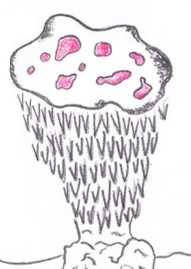
References
Header
The photograph at the top of each page in this site was taken by Hugh Erle Smith.
Personal
Volk, T. 2012. Personal Communication
Text
Agerer, R. 1993. Ectomycorrhizae of Hydnellum peckii on Norway Spruce and their chlamydospores. Mycologia. 85(1):74-83.
Campbell, N.A., J.B. Reece, L.A. Urry, M.L. Cain, S.A. Wasserman, P.V. Minorsky and R.B. Jackson. 2008. Biology: Eighth Edition. Pearson Benjamin Cummings, San Francisco, California, USA.
Holden, Liz. 2008. Scotland's rare tooth fungi: an introduction to their identification, ecology, and management. Plantlife International. Striling, Scotland.
Khanna, M.J., M.H. Malone, K.L. Euler, and L.R. Brady. 1965. Atromentin. anticoagulant from Hydnellum diabolus. Journal of Pharmaceutical Scineces. 54(7):1016-1020
Kwak, J.Y, I.K. Rhee, K.B. Lee, J.S. Hwang and I.D. Yoo. 1999. Thelephoric acid and kynapcin-9 in mushroom Polyozellus multiflex inhibit prolyl endopeptidase in vitro. Journal of microbiology and biotechnology 9(6): 798-803.
Moore, D., G.D. Robson and A.P.J. Trinici. 2011. 21st Century Guidebook to Fungi. Cambridge University Press, Cambridge, England.
Landeweert, R., E. Hoffland, R.D. Finlay, T.W. Kuyper and N. van Breemen. 2001. Linking plants to rocks: ectomycorrhizal fungi mobilize nutrients from minerals. Trends in Ecology and Evolution. 16:248-254.
Misra, K.A., J.P. Tewari and S.K. Deshmukh. 2012. Systematics and Evolution of Fungi. Science Publishers, Enfield, New Hampshire, USA.
Newton, A.C, E. Holden, L.M .Davy, S.D. Ward and L.V. Fleming. 2002. Status and distribution of stipitate hydnoid fungi in Scottish coniferous forests. Biological Conservation 107(2): 181-192.
Parfitt, D.A, A.M. Ainsworth, D. Simpson, H.J. Rogers and L. Boddy. 2007. Molecular and morphological discrimination of stipitate hydnoid in the genera Hydnellum and Phellodon. Mycological Research. 11:761-777.
Rice , M. and D. Beebee. Mushrooms for Color. 1980. Mad Rivers Press, Eureka, California, USA.
Roberts, P. and S. Evans. The Book of Fungi: a life-size guide to six hundred species from around the world. 2011. The University of Chicago Press, Chicago, Illinois, USA.
Van der Linde, S., I.J. Alexander and I.C. Anderson. 2008. A PCR-based method for detecting the mycelia of stipitate hydnoid fungi in soil. Journal of Microbiological Methods 75(1): 40-46.
Van der Linde, S., I. J. Alexander and I. C. Anderson. 2009. Spatial distribution of sporocarps of stipitate hydnoid fungi and their belowground mycelium. FEMS Microbiology Ecology 69(3): 344-352.
Van der Linde, S., I.J. Alexander and I. C. Anderson. 2010. Do stipitate hydnoid fungi have the ability to colonise new native pine forest? Fungal Ecology 3(2): 89-93.
Visser, S. 1995. Ectomycorrhizal Fungal Succession In Jack Pine Stands Following Wildfire. New Phytologist 129(3): 389-401.
Westmoreland, S.E. 2003. Morphological and Molecular Studies in Hydnellum (Basidiomycota, Thelephoraceae), Reinforced with a New Method, Chemosystematics with HPLC using Mass Spectroscopy (CHUMS). University of Wisconsin-La Crosse, La Crosse, Wisconsin, USA.
Zheng, C.J., M.J. Sohn and W.G. Kim. 2006: Atromentin and leucomelone, the first inhibitors specific to enoyl-ACP reductase (FabK) of Streptococcus pneumoniae. The Journal of Antibiotics 59(12): 808-812.
Online
1)Encyclopedia of Life, 2012.<url:http://eol.org/pages/198192/overview>
2)Fungi-zette, 2011.
3)Fungionline, 2011.<url:http://www.fungionline.org.uk/3hyphae/3septa.html>
4)Hodge, Kathie. Peck Foray, 2012.
5)Mushroom Observer, 2011.<url:http://mushroomobserver.org/name/show_name/232?_js=on&_new=true>Accessed 6 November, 2012.
6)New York State Museum, 2012.
7)Smith, Hugh. Hugh Erle Smith's Website, 2011.<url:http://www.hughsmith.org/index.html>
8)Tree of Life, 2007.<url:http://tolweb.org/Homobasidiomycetes>
9)WNYC Radio. 2012. The Perfect Yellow. Radiolab. Podcast retrieved from <http://www.radiolab.org/2012/may/21/perfect-yellow/> Accessed 4 October, 2012.
